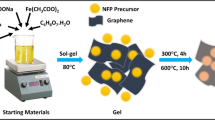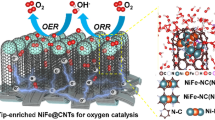Abstract
Exhibiting a very high surface area, a good electrical conductivity and a high density of active sites, nitrogen-doped graphenic materials are considered as promising catalysts for the oxygen reduction reaction (ORR). Seldom studied in acidic media, N-doped graphenic foams were tested here as the cathode catalysts of a polymer electrolyte membrane fuel cell (PEMFC). The materials were prepared via a solvothermal-based process, by reacting either cyclohexanol and ethanolamine or 1-(2-hydroxyethylethyl) piperidine with metallic sodium, under high pressure and temperature. Membrane electrode assemblies were prepared with a Pt/C anode, 212 Nafion membrane, and an 8 mm disk cathode based on the graphenic materials. The performance exhibited by the PEMFC was evaluated using chronopotentiometry and impedance spectroscopy, depending on the synthesis conditions. The kinetic parameters of the ORR were estimated by interpretation of the experimental data: the high Tafel slope found might express the partial control of oxygen diffusion through the graphenic microporous structure. Relationships between the electrochemical behavior of the materials and their structural properties are discussed. Moderately crystallized materials with a low oxygen content showed the highest catalytic properties, with a current density larger than 30 mA cm−2 and a maximum power density at 2.3 mW cm−2.
Graphic abstract










Similar content being viewed by others
References
Gröger O, Gasteiger HA, Suchsland J-P (2015) Review—electromobility: batteries or fuel cells? J Electrochem Soc 162:2605–2622. https://doi.org/10.1149/2.0211514jes
Karan HI, Sasaki K, Kuttiyiel K, Farberow CA, Mavrikakis M, Adzic RR (2012) Catalytic activity of platinum monolayer on iridium and rhenium alloy nanoparticles for the oxygen reduction reaction. ACS Catal 2:817–824. https://doi.org/10.1021/cs200592x
Zhang G, Shao Z-G, Lu W, Li G, Liu F, Yi B (2012) One-pot synthesis of Ir@Pt nanodendrites as highly active bifunctional electrocatalysts for oxygen reduction and oxygen evolution in acidic medium. Electrochem Commun 22:145–148. https://doi.org/10.1016/j.elecom.2012.05.030
Zhu H, Zhang S, Guo S, Su D, Sun S (2013) Synthetic control of FePtM nanorods (M = Cu, Ni) to enhance the oxygen reduction reaction. J Am Chem Soc 135:7130–7133. https://doi.org/10.1021/ja403041g
Mani P, Srivastava R, Strasser P (2008) Dealloyed Pt−Cu core−shell nanoparticle electrocatalysts for use in PEM fuel cell cathodes. J Phys Chem C 112:2770–2778. https://doi.org/10.1021/jp0776412
Robinson Z (2017) Sustainability of platinum production in South Africa and the dynamics of commodity pricing. Resour Policy 51:107–114. https://doi.org/10.1016/j.resourpol.2016.12.001
Government publishing office (2018) Mineral commodities summary 2018. (US Govt. Printing Office)
Zhang Y, Ge J, Wang L, Wang D, Ding F, Tao X, Chen W (2013) Manageable N-doped graphene for high performance oxygen reduction reaction. Sci Rep. https://doi.org/10.1038/srep02771
Zhang L, Xia Z (2011) Mechanisms of oxygen reduction reaction on nitrogen-doped graphene for fuel cells. J Phys Chem C 115:11170–11176. https://doi.org/10.1021/jp201991j
Zhang L, Niu J, Dai L, Xia Z (2012) Effect of microstructure of nitrogen-doped graphene on oxygen reduction activity in fuel cells. Langmuir 28:7542–7550. https://doi.org/10.1021/la2043262
Duan J, Chen S, Jaroniec M, Qiao SZ (2015) Heteroatom-doped graphene-based materials for energy-relevant electrocatalytic processes. ACS Catal 5:5207–5234. https://doi.org/10.1021/acscatal.5b00991
Ma R, Ren X, Xia BY, Zhou Y, Sun C, Liu Q, Liu J, Wang J (2016) Novel synthesis of N-doped graphene as an efficient electrocatalyst towards oxygen reduction. Nano Res 9:808–819. https://doi.org/10.1007/s12274-015-0960-2
Shao Y, Zhang S, Engelhard MH, Li G, Show G, Wang Y, Liu J, Aksay IA, Lin Y (2010) Nitrogen-doped graphene and its electrochemical applications. J Mater Chem 20:7491–7496. https://doi.org/10.1039/c0jm00782j
Song C (2002) Fuel processing for low-temperature and high-temperature fuel cells challenges, and opportunities for sustainable development in the 21st century. Catal Today 77:17–49. https://doi.org/10.1016/S0920-5861(02)00231-6
Huang J, Han J, Gao T, Zhang X, Li J, Li Z, Xu P, Song B (2017) Metal-free nitrogen-doped carbon nanoribbons as highly efficient electrocatalysts for oxygen reduction reaction. Carbon 124:34–41. https://doi.org/10.1016/j.carbon.2017.08.033
Geng D, Chen Y, Chen Y, Li Y, Li R, Sun X, Ye S, Knights S (2011) High oxygen-reduction activity and durability of nitrogen-doped graphene. Energy Environ Sci 4:760–764. https://doi.org/10.1039/c0ee00326c
Qu L, Liu Y, Baek J-B, Dai L (2010) Nitrogen-doped graphene as efficient metal-free electrocatalyst for oxygen reduction in fuel cells. ACS Nano 4:1321–1326. https://doi.org/10.1021/nn901850u
Inagaki M, Toyoda M, Soneda Y, Morishita T (2018) Nitrogen-doped carbon materials. Carbon 132:104–140. https://doi.org/10.1016/j.carbon.2018.02.024
Quílez-Bermejo J, González-Gaitán C, Morallón E, Cazorla-Amorós D (2017) Effect of carbonization conditions of polyaniline on its catalytic activity towards ORR. Some insights about the nature of the active sites. Carbon 119:62–71. https://doi.org/10.1016/j.carbon.2017.04.015
Wu P, Du P, Zhang H, Cai C (2013) Microscopic effects of the bonding configuration of nitrogen-doped graphene on its reactivity toward hydrogen peroxide reduction reaction. Phys Chem Chem Phys 15:6920–6928. https://doi.org/10.1039/c3cp50900a
Guo D, Shibuya R, Akiba C, Saji S, Kondo T, Nakamura J (2016) Active sites of nitrogen-doped carbon materials for oxygen reduction reaction clarified using model catalysts. Science 351:361–365. https://doi.org/10.1126/science.aad0832
Lai L, Potts JR, Zhan D, Wang L, Poh CK, Tang C, Gong H, Shen Z, Lin J, Ruoff RS (2012) Exploration of the active center structure of nitrogen-doped graphene-based catalysts for oxygen reduction reaction. Energy Environ Sci 5:7936–7942. https://doi.org/10.1039/c2ee21802j
Florent M, Wallace R, Bandosz TJ (2019) Oxygen electroreduction on nanoporous carbons: textural features vs nitrogen and boron catalytic centers. ChemCatChem 11:851–860. https://doi.org/10.1002/cctc.201801675
Jiang Y, Yang L, Sun T, Zhao J, Lyu Z, Zhuo O, Wang X, Wu Q, Ma J, Hu Z (2015) Significant contribution of intrinsic carbon defects to oxygen reduction activity. ACS Catal 5:6707–6712. https://doi.org/10.1021/acscatal.5b01835
Ikeda T, Boero M, Huang S-F, Terakura K, Oshima M, Ozaki J-I (2008) Carbon alloy catalysts: active sites for oxygen reduction reaction. J Phys Chem C 112:14706–14709. https://doi.org/10.1021/jp806084d
Franck-Lacaze L, Bonnet C, Choi E, Moss J, Pontvianne S, Poirot H, Datta R, Lapicque F (2009) Ageing of PEMFCs due to operation at low current density: investigation of oxidative degradation. Int J Hydrogen Energy 34:10472–10481. https://doi.org/10.1007/s10800-012-0451-z
Moumaneix L, Fontana S, Dossot M, Lapicque F, Hérold C (2020) Nitrogen-doped graphenic foam synthesized by solvothermal-based process: effect of pyrolysis temperature on the material properties. Microporous Mesoporous Mater. https://doi.org/10.1016/j.micromeso.2020.110165
Speyer L, Fontana S, Cahen S, Ghanbaja J, Medjahdi G, Hérold C (2015) Multi-scale characterization of graphenic materials synthesized by a solvothermal-based process: influence of the thermal treatment. Solid State Sci 50:42–51. https://doi.org/10.1016/j.solidstatesciences.2015.10.009
Liu J, Sasaki K, Lyth SM (2013) Electrochemical oxygen reduction on metal-free nitrogen-doped graphene foam in acidic media. ECS Trans 58:1529–1540. https://doi.org/10.1149/05801.1529ecst
Perry ML, Newman J, Cairns EJ (2019) Mass transport in gas-diffusion electrodes: a diagnostic tool for fuel-cell cathodes. J Electrochem Soc 145:5–15. https://doi.org/10.1149/1.1838202
Tant S, Rosini S, Thivel P-X, Druart F, Rakotondrainibe A, Geneston T, Bultel Y (2014) An algorithm for diagnosis of proton exchange membrane fuel cells by electrochemical impedance spectroscopy. Electrochim Acta 135:368–379. https://doi.org/10.1016/j.electacta.2014.04.108
Byambasuren U, Jeon Y, Altansukh D, Ji Y, Shul Y-G (2016) The particle size effect of N-doped mesoporous carbons as oxygen reduction reaction catalysts for PEMFC. Korean J Chem Eng 33:1831–1836. https://doi.org/10.1007/s11814-016-0030-9
Eckmann A, Felten A, Mishchenko A, Britnell L, Krupke R, Novoselov KS, Casiraghi C (2012) Probing the nature of defects in graphene by Raman spectroscopy. Nano Lett 12:3925–3930. https://doi.org/10.1021/nl300901a
Piscanec S, Mauri F, Ferrari AC, Lazzeri M, Robertson J (2005) Ab initio resonant Raman spectra of diamond-like carbons. Diam Relat Mater 14:1078–1083. https://doi.org/10.1016/j.diamond.2004.11.043
Bhaumik A, Haque A, Taufique M, Karnati P, Patel R, Nath M, Ghosh K (2017) Reduced graphene oxide thin films with very large charge carrier mobility using pulsed laser deposition. J Mater Sci Eng. https://doi.org/10.4172/2169-0022.1000364
Smith MW, Dallmeyer I, Johnson TJ, Brauer CS, McEwen J-S, Espinal JF, Garcia-Perez M (2016) Structural analysis of char by Raman spectroscopy: improving band assignments through computational calculations from first principles. Carbon 100:678–692. https://doi.org/10.1016/j.carbon.2016.01.031
Bokobza L, Bruneel J-L, Couzi M (2015) Raman spectra of carbon-based materials (from graphite to carbon black) and of some silicone composites. Carbon 1:77–94. https://doi.org/10.3390/c1010077
Dresselhaus MS, Jorio A, Saito R (2010) Characterizing graphene, graphite, and carbon nanotubes by raman spectroscopy. Annu Rev Condens Matter Phys 1:89–108. https://doi.org/10.1146/annurev-conmatphys-070909-103919
Park S, Hu Y, Hwang JO, Lee E-S, Casabianca LB, Cai W, Potts JR, Ha H-W, Chen S, Oh J, Kim SO, Kim Y-H, Ishii Y, Ruoff RS (2012) Chemical structures of hydrazine-treated graphene oxide and generation of aromatic nitrogen doping. Nat Commun. https://doi.org/10.1038/ncomms1643
Zhu Y, Huang H, Zhou W, Li G, Liang X, Guo J, Tang S (2017) Low temperature reduction of graphene oxide film by ammonia solution and its application for high-performance supercapacitors. J Mater Sci Mater Electron 28:10098–10105. https://doi.org/10.1007/s10854-017-6771-3
Acknowledgements
This work was partly supported by the French PIA project “Lorraine Université d’Excellence”, reference ANR-15-IDEX-04-LUE.
Author information
Authors and Affiliations
Corresponding author
Additional information
Publisher's Note
Springer Nature remains neutral with regard to jurisdictional claims in published maps and institutional affiliations.
Rights and permissions
About this article
Cite this article
Moumaneix, L., Fontana, S., Hérold, C. et al. Metal-free nitrogen-doped graphenic materials as cathode catalysts for the oxygen reduction reaction in polymer electrolyte membrane fuel cells. J Appl Electrochem 51, 727–738 (2021). https://doi.org/10.1007/s10800-021-01532-6
Received:
Accepted:
Published:
Issue Date:
DOI: https://doi.org/10.1007/s10800-021-01532-6




